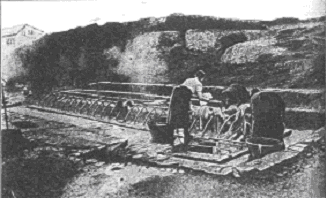Still more: Not many years ago, in a particulary open season, the American whaler, Captain Keenan, reported that he saw a land northeast of Point Barrow. Peary, from Cape Thomas Hubbard, sighted distant peaks northwest. Such evidence is incontrovertible. The new continent seems already within our grasp!
So much for the land-mass.
Now for its probable inhabitants.
Eric the Red discovered Greenland in 985 A.D. He brought back glowing tales of grassy fiords, long sunlit days, game-infested hills, ice-pans groaning under their burden of fat seals, bays teeming with fish.
Vikings Prosper
Colonization began at once. And so true did
Eric's bright tale prove that the Vikings greatly prospered. In the
archives at Bergen may be seen today the receipts for their princely
contributions in ivory and oil to the ill-fated
Crusades.
The last ship known to have returned
to Norway from her arctic colonies arrived in the year 1410. We read that
it brought a rich cargo; that its report was of happy, thriving Norsemen
back north; of health and growing independence despite their rigorous
environment.
An Adventure in the Icy Desert
"With my own eyes I have seen in Greenland the ruined stone houses of the lost Norwegian colony", writes Commander Green. "With Donald B. MacMillan I have tried to reach the polar continent, believed to lie in the Polar Sea North of Canada."
As an arctic explorer of wide experience, Commander Green - now aid to Admiral Williams, President of the Naval War College at Newport, R.I. - has made an exhaustive study of the fascinating possibilities of discovery of which he writes. Following his graduation from the United States Naval Academy at Annapolis, he joined the Crocker Land Arctic Expedition as engineer and physicist in 1913. He spent 3 ½ years in the polar regions.
In the spring of 1914, with MacMillan and two Eskimos, he sledged more than 1,000 miles up across Ellesmere Land and out into the Polar Sea in search of land that tidal experts insist must lie in this million square miles of unexplored area. They also explored an unknown portion of Axel Heiberg's Land.
Then, as in 1914, Europe became a shambles. Plague and war swept civilization. Pestilential disease ran a ghastly race with a horde of human murderers. Even the sea route north was forgotten...
Lost Colony a World Riddle
Dark ages passed, Nature bred again in men
the will to search her world for knowledge and for wealth. Greenland was
rediscovered. Hans Egede established the first modern settlement there in
1721. But the grim report he made was tragic beyond
belief:
The Norwegian colony, 10,000 people
- perhaps 100,000 - had, to a man, mysteriously
disappeared!
"The greatest riddle in the
history of the world," it has been called - the baffling mystery of the
lost Norse colony.
Where did they
go?
Where didn't they go is a question more
easily answered. Not to sea in ships, for they had but one or two; and
Greenland, lying above the tree-line, gave them no timber for building
more. Not slain by Eskimos, for Eskimos are the most peace-loving people
in the world, knowing nothing of the art of war. Not, like Europe, swept
by some dread germ of awful virulence, for germs don't thrive in polar
regions.
What
then?
Examine the Eskimo tradition: It paints
in vivid terms the White Men swarming suddenly north to a wonderland the
natives long had known. Because of evil spirits, no Eskimo had ever dared
this trail.
